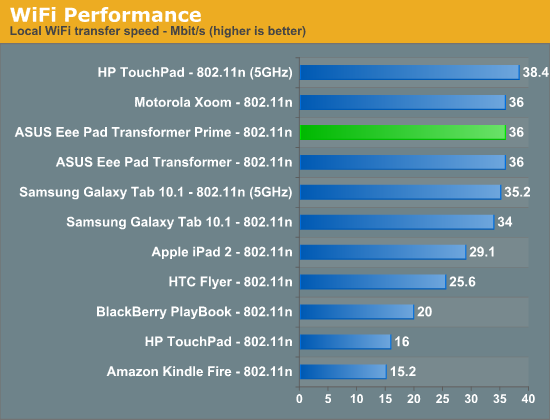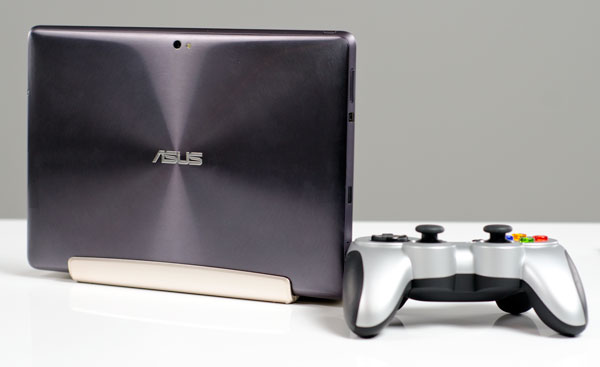ASUS Eee Pad Transformer Prime Review Part II: Battery Life & More
by Anand Lal Shimpi on December 15, 2011 3:45 AM ESTIn our original review of the ASUS Eee Pad Transformer Prime I did the best I could do given limited testing opportunity with the platform before the NDA lifted on all the reviews. I made the commitment back then to come back with additional findings after I had spent more time with the platform. Today I'm back to make good on that promise.
Two more Eee Pad Transformer Prime samples later and here we are. Next week retailers and etailers should begin shipping the first orders of the Prime out to customers. There were a number of gaps I wasn't happy with in our original review of the Prime, and I've spent the past couple of weeks trying to fill them. Even what I'm presenting today isn't perfect, but when combined with the original review it should paint a more complete picture of the Eee Pad Transformer Prime.
And I've got video, something I had to cut out of the original review due to time constraints:
The WiFi Story
I'm on my third Transformer Prime. The original sample was almost completely broken when it came to wireless connectivity. I had very little range on the integrated WiFi and performance typically hovered around 0.5Mbps, sometimes reaching as high as 2Mbps. ASUS originally claimed that no one else had this issue but it looks like the CNet reviewer also noticed it. That sample went back to ASUS for diagnosis but I don't have the results back from the autopsy yet. A simple guess would be an antenna that wasn't properly connected, although it could just as easily have been something more complicated.
ASUS overnighted me a second Transformer Prime; this one was tested at ASUS in California before making its way out to me. As I published earlier, I had issues with the second sample and any Apple wireless access points (Time Capsule or Airport Extreme). Using a Netgear AP I saw 16Mbps pretty consistently, but I could only get ~32Mbps if the tablet was at the right orientation with respect to the AP. ASUS' HQ eventually conceded that there might have been a problem with the second WiFi antenna on pre-production review samples. Apparently this issue was fixed in the retail lot, but may not have been addressed in what ASUS originally shipped us. Wait—second WiFi antenna?
It turns out that the Eee Pad Transformer Prime features WiFi antenna diversity. We've talked about antenna diversity most often with reference to the cellular chain on Apple's iPhone 4 and 4S, but here it's present on the Prime's WiFi. There are two antennas on the Transformer Prime, one located on either side of the front facing camera. In the second Transformer Prime sample, one of the two wasn't working. In my third review sample, taken from the retail lot that's on its way to vendors this week, both were fully functional. The result is peak WiFi performance that is virtually identical to the original Eee Pad Transformer.

There is no RF window on the back of the Prime where the two antennas are located. Aluminum does a fairly good job of attenuating RF signals, which contributes to worse range on WiFi than the original plastic Eee Pad Transformer. WiFi performance at the edge of reception as well as the maximum usable WiFi range are both noticeably lower than its predecessor. I'm still finalizing our tablet WiFi range tests to be able to quantify some of this stuff, but it's safe to say that if you were at the edge of WiFi coverage on the original Transformer, the Prime won't be any better.

















58 Comments
View All Comments
metafor - Thursday, December 15, 2011 - link
Yes. Since Tegra 3 is actually capable of clock-gating individual cores as opposed to all-or-nothing like Tegra 2, power utilization should be better.That in combination with display local dimming and lower voltage -- since the CPU's are made on 40G -- definitely help brings per-core power down.
The question is whether or not the performance is there to compete with SoC's on Android early next year with Samsung's new Exynos and Krait based devices.
TareX - Thursday, December 15, 2011 - link
Quite off topic, but I expected Anand's Galaxy Nexus review to be out by US launch day...Death666Angel - Thursday, December 15, 2011 - link
Is it now the norm to compare products based on their size rather than ability and, most importantly, price? A Netbook probably retails for $250-$400. This thing retails for $650 (with dock)? I don't see how this in any way compares to a netbook. Sorry.quiksilvr - Thursday, December 15, 2011 - link
It isn't fair comparing the two because the ASUS has a 10.1" screen at 1280x800, not a 9.7" screen at 1024x768. Thats a 0.78MP screen vs a 1.0MP screen. It has to render 20% more pixels and on top of that the screen is larger.quiksilvr - Thursday, December 15, 2011 - link
I'm referring to battery life.Confusador - Thursday, December 15, 2011 - link
Thanks for doing the follow up on this, demonstrating once again why you're the best in the business.Hopefully Asus will learn from this; if you weren't as thorough as you are they would have ended up with their only review here being unnecessarily negative. Maybe they'll give folks more lead time in the future!
fteoath64 - Friday, December 16, 2011 - link
So there is just some improvement and not a great deal of improvement. Wonder if it would be better if Nvidia put two 1.8Ghz cores rather than 4 1.4Ghz core, then the end result in performance would be way better with slight penalty on battery life ?.I guess I have to wait for the A15 cores then!.
Mugur - Friday, December 16, 2011 - link
Asus should've done the impossible and have it ready by Christmas with ICS on it and aggresively priced. It would've been an instant hit.vcarvega - Friday, December 16, 2011 - link
I do think it is commendable of you to update your original review with these updated tidbits. However, I do wonder when it comes to your gripes, particularly with multitasking.I agree with the limitations of Honeycomb's multitasking, but what are we comparing it too? Your review was specifically comparing it to a netbook, so your criticism is fair if we're comparing it to Win XP... but compared to other mobile OS', it's the best on offer (admittedly, I have not tried the Playbook's implementation of multitasking which looks like it may be more comparable to a desktop experience).
Currently, I think heavy users run into serious limitation regardless of which tablet platform they are using. I think I was hoping for quad core to change this as well tho... so that's disappointing. Maybe ICS?
Your comments on higher clocked, dual-core 28nm chips possibly being comparable in performance to Tegra 3 gave me reason to pause as well! Simply b/c I fear that Android 4.0 is still being optimized for dual core devices, not quad core... Because unless things change at CES, most new mobile devices being announced for 2012 still have dual cores!
vision33r - Friday, December 16, 2011 - link
Really bad timing. There are so many phones out right now that makes the Razr look outdated.For starters, this phone doesn't even beat the SSGS2 which came out more than 6 months ago.
Now we have GalaxyNexus Prime, HTC Rezound. Upcoming phones will all have LTE, 720p displays, and better performance.